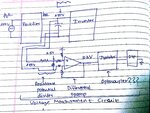ans94
Newbie level 5
I have to measure voltage across capacitor which acts as a dc source in a cascaded h-bridge inverter and input it to the dsp (digital signal processor). I have designed a voltage measurement circuit which senses the pulsating dc voltage across the capacitor and steps it down to 3.3V (since the max voltage input to the dsp is 3.3V ) using a voltage divider circuit and a differential opamp. Now before giving the 3.3V output to the dsp, I need to isolate it. What is the possible method to do so? Can i use an optocoupler? I have gone through few optocouplers but am not sure which one to use and how to use it.
